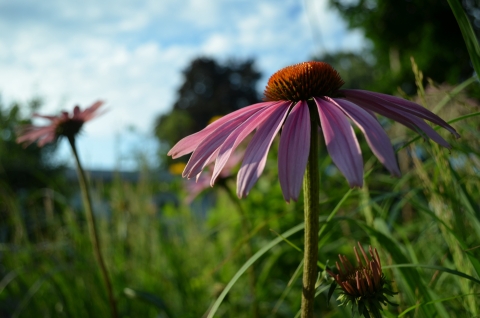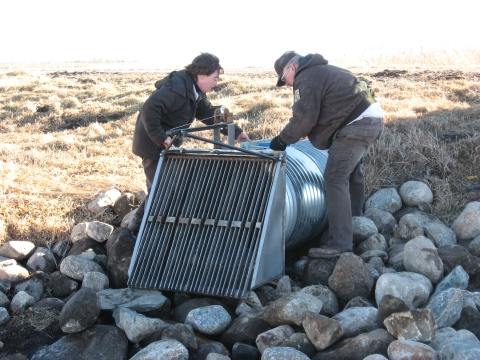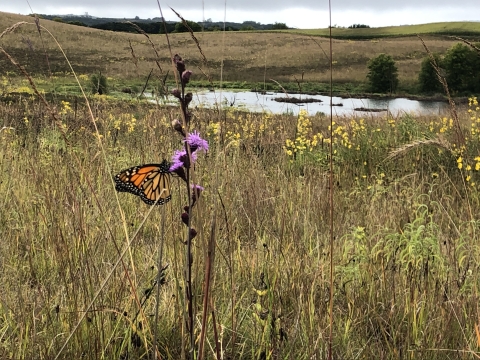What We Do
Wetland management districts use a wide range of land management tools based on the best science available. Some districts use prescribed fires to mimic natural fires that would have cleared old vegetation from the land helping native plants regenerate and local wildlife to thrive. Other districts contain wilderness areas where land is largely managed passively. Management tools aim to ensure a balanced conservation approach where both wildlife and people benefit. At this field station, our conservation toolbox includes grassland and wetland restoration techniques such as prescribed fire, invasive tree removal, seeding native plant species, control of invasive thistles, invasive fish control, and trapping.
Management and Conservation
The National Wildlife Refuge System is a network of lands and waters owned and managed by the U.S. Fish and Wildlife Service. Wildlife conservation is at the heart of the refuge system. It drives everything we do from the purpose a refuge or district is established, to the recreational activities offered there, to the resource management tools we use. Selecting the right tools helps us ensure the survival of local plants and animals and helps fulfill the purpose of the district.
Habitat management activities on waterfowl production areas focus on the restoration and maintenance of grasslands and associated wetlands for the benefit of waterfowl and other migratory birds. Tools available include prescribed fire, water level manipulation, waterfowl nesting structures, mowing, tree and brush removal, haying, and grazing, where appropriate.
District staff work with private landowners and form effective partnerships to restore and/or enhance drained wetlands and some grasslands within the five-county working area. With landowner approval, bulldozers and backhoes are used to plug drainage ditches, break drain tiles and install water control structures to maintain desired water levels of the wetlands. In time, it is possible to revive wetlands that were once drained and forgotten. Once restored, they can carry on their vital role as part of the prairie landscape.
Grassland Restoration
Much of the land in the prairie pothole region has historically been farmed. When the district acquires a new tract of land, it restores the wetlands on the new property and seeds the uplands with native origin grasses and wildflowers, also known as forbs. The district harvests some of the needed seed from local native prairies, and also purchases some local origin grass and forb seeds to diversify the seed mix.
A diverse seed mixture is important because the wildflowers provide food for many species of insects. Grassland birds feed on the insects found in these prairies. A grassland tract with diverse species composition can support more wildlife that is dependent on that food source. Plant species diversity also provides variability in the grassland structure. Some wildlife species need dense grasses overhead and passageways near the ground, while others like shorter, open areas in a grassland. Plant diversity provides better cover, nesting habitat, and food for a larger variety of wildlife species.
Prairie Fires and Grazing
Fire was a natural event on the northern tallgrass prairie and was started by lightning or indigenous hunters who were driving game. In western Minnesota, fire was the dominant force in shaping grasslands. This area generally receives enough rain to support trees, but fire, bison grazing, and periodic drought helped keep forests from expanding westward.
As humans settled and the prairie was broken and fragmented, fires could not carry across the expanses they once did. Whether it was a fire or intense short-term grazing by nomadic bison, grassland plants evolved a dependence on frequent disturbance. Today, fire, haying, and grazing are used to stimulate native grasses. The district has to rely on local farmers and ranchers for assistance with haying and grazing. These activities can be detrimental if they are not carefully planned. Fire can be an inexpensive and controlled way for us to successfully manage prairie tracts.
Fires are conducted by highly trained staff using a variety of specialized equipment such as fire engines, drip torches, all-terrain vehicles and water pumpers. Conditions like wind direction, wind speed, temperature, relative humidity, safety and smoke dispersal have to meet a designated set of criteria referred to as a prescription. A plan must be written that sets those criteria and provides guidelines for potential issues that could arise during a prescribed fire. If those criteria are met, the fire can be conducted.
Large tracts are frequently divided into smaller burn units that are more manageable as well as biologically beneficial. Leaving a portion of a tract unburned provides a refuge for animals and insects that will return to the burned area as it begins to grow again. A burn unit is typically burned once every three to seven years. When establishing new grassland, it can be beneficial to burn it both the third and fifth year after seeding. Grasslands are burned primarily in spring and fall but may be burned in summer also. The timing of the burn depends on the objective for that tract of land. Some of our burn objectives include stimulating grassland seeding or native prairie, setting back the growth of invading trees, removing plant litter that has built up over time, reducing fuel or layers of plant litter around towns, rural homes and barns, and stimulating grassland plant seed production.
Prairie plants evolved with fire and grow vigorously and produce more seed following a fire. They grow more robust after a fire because the plant litter has been removed from the soil surface, which results in higher soil temperatures and increased nutrient availability. Prairie animals also evolved with fire and usually escape unharmed. Burrowing animals seek shelter from fire in their underground burrows. Birds can fly and animals can run away from oncoming fire. Some nests are destroyed by fire, but ground nesting birds like waterfowl, prairie chickens, and songbirds have evolved with fire and predation. When a nest is lost, these species will usually re-nest. Because predation is so high on ground nesting birds, re-nesting is the only way these species have successfully maintained their populations over time. Nesting cover and food provided by the robust and diverse plant growth that follows a fire generally benefits ground nesting birds for four to six years after the fire.
Wetland Restoration
When the Fergus Falls Wetland Management District acquires a new tract of land, one of the first things done on the new unit is wetland restoration. A wetland biologist analyzes the property and determines where wetlands have been drained or filled. Then heavy equipment is used to plug ditches, break tile lines and scrape out soils to restore wetlands to their natural depth. Once the dirt work has been completed, the wetlands are allowed to fill with water naturally through rainwater run-off and snow melt in the spring. If determined feasible and appropriate, water level control structures are sometimes installed so that water levels can be managed to maximize the habitat value.
Invasive Fish
Invasive fish have become a problem in many wetlands in Minnesota. These fish disrupt natural processes in wetlands sometimes causing poor water quality and reducing the value of those wetlands for wildlife. Invasive fish can be eradicated from marshes if a wetland is drawn down before winter. The fish will freeze out or die from oxygen depletion over the winter. When we use drawdowns to remove fish, a barrier is necessary to keep fish from re-entering the system. We use sloped, smooth pipes called velocity tubes, pipe elbows, rotating screens or swinging fingers to prevent fish from moving upstream into managed wetlands. Invasive fish can also be removed by stocking predator fish or chemical treatment with rotenone, which is a chemical derived from the roots of a South American plant. Rotenone kills fish by disrupting the way they absorb oxygen into their cells. All three methods of removing invasive fish can improve wetland quality and wildlife habitat.
Land Acquisition
The Migratory Bird Hunting and Conservation Act (the Duck Stamp Act) authorizes the purchase of lands using the revenue from the sale of Federal Duck Stamps for the purpose of improving the production of migratory birds, especially waterfowl. Under this program both fee title lands and easements are purchased to protect migratory bird habitat.
Fee Title Lands
Waterfowl production areas are fee title public lands purchased with federal duck stamp revenue. While many national wildlife refuges protect large blocks of land, waterfowl production areas are small, ranging in size from as little as 10 acres to nearly 2,000 acres. They are often broadly dispersed over many counties. More than 3,000 waterfowl production areas have been purchased since 1958 when Congress authorized the use of ducks stamp monies for purchasing small wetlands. Waterfowl production areas are open to the public for wildlife-dependent outdoor recreational activities.
Easements
The Duck Stamp Act also funds the purchase of wetland and habitat easements. These are not fee-title lands. An easement is a right to use someone else’s land for a specific purpose. In our case, that purpose is to provide nesting and migratory habitat for waterfowl and prairie specialist species like bobolink and meadowlark. Landowners selling easements to the district retain ownership and private control of their land, and they receive a one-time payment. Easements protect habitats that benefit wildlife and simultaneously provides landowners with opportunities for continued land use such as grazing, haying, or farming.
Wetland Easements
The wetland easement involves a signed agreement with a landowner protecting wetlands on their land from being burned, drained, filled, or leveled in perpetuity. The landowner receives a one-time payment for protecting the wetlands. When protected wetlands go through dry cycles, they can be farmed, grazed or hayed without violating the agreement. The land remains in private control and ownership, and the landowner controls access to these wetlands.
Habitat or Grassland Easements
Habitat easements generally protect both grassland and wetland habitat, but again the property remains in private control and ownership, and the landowner allows access. The landowner may be offered one of several options. The first option is complete protection of wetlands and grassland on their property. With this easement, the government purchases the rights to graze, hay, farm, drain, and harvest seed from the property. Two other options allow the landowner to either hay or graze. With any of these options, the landowner receives a one-time payment for the rights that the U.S. Fish and Wildlife Service purchases from them. The haying and grazing option allows the landowner to hay after July 15 and graze, but the U.S. Fish and Wildlife Service purchases the rights to farm and drain.
- The haying option purchases all of the above rights except the right to hay or harvest seed. The landowner can hay or harvest seed after July 15th each year, which allows most ground nesting birds to hatch their eggs before any cutting is done.
- The grazing option allows the landowner to graze the land with no restrictions, but the U.S. Fish and Wildlife Service still purchases the rights to hay, harvest seed, farm, and drain.
If any of these options to protect your land and provide habitat for migratory birds and prairie specialists sound appealing to you, please contact the Fergus Falls Wetland Management District for more information about these programs. Call 218-739-2291.
Trapping Occurs on this Wetland Management District
Trapping is a wildlife management tool used on some national wildlife refuge national wildlife refuge
A national wildlife refuge is typically a contiguous area of land and water managed by the U.S. Fish and Wildlife Service for the conservation and, where appropriate, restoration of fish, wildlife and plant resources and their habitats for the benefit of present and future generations of Americans.
Learn more about national wildlife refuge system lands. Trapping may be used to protect endangered and threatened species or migratory birds or to control certain wildlife populations. The U.S. Fish and Wildlife Service also views trapping as a legitimate recreational and economic activity when there are harvestable surpluses of fur-bearing mammals. Outside of Alaska, refuge system lands that permit trapping as a recreational use may require trappers to obtain a special use permit. Signs are posted at district offices where trapping occurs. Contact the district manager for specific regulations.
Law Enforcement
U.S. Fish and Wildlife Service law enforcement officers have a wide variety of duties and responsibilities. Officers help visitors understand and obey wildlife protection laws. They work closely with state and local government offices to enforce federal, state and refuge hunting regulations that protect migratory birds and other game species from illegal take and preserve legitimate hunting opportunities. Thank you for caring about wild places and wild things. You can help by reporting injured wildlife, wildlife crimes or suspicious activity to our office.
Laws and Regulations
Fergus Falls Wetland Management District conserves wildlife and natural habitats through a variety of national laws created by Congress in Washington D.C. The district also enforces more localized rules and regulations to help ensure that your visit is safe and enjoyable. Thank you for helping wildlife by familiarizing yourself with the activities you can participate in on these special lands and waters.




